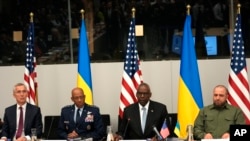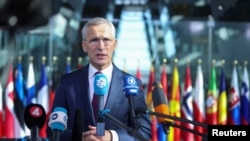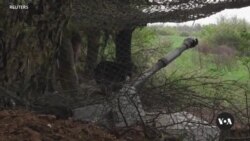U.S. Defense Secretary Lloyd Austin would not confirm or deny reports that the U.S. is sending another Patriot surface-to-air missile defense system to Ukraine, after allies and partners from about 50 nations met to coordinate support for Kyiv in a meeting heavily focused on air defense.
"What I will tell you is that there will be no change in our Patriot coverage in Poland … there is no change in our Patriot coverage there," he told reporters at a press conference at NATO headquarters after the 23rd meeting of the Ukraine Defense Contact Group (UDCG), a coalition of about 50 nations that coordinating military support for Kyiv in its fight against Russia's invasion.
The New York Times and The Associated Press reported earlier this week that the United States is providing another Patriot system, citing defense officials who were granted anonymity to discuss the move. The Times reported that the Patriot battery would come from Poland, where it has been protecting a rotational force of American troops as they return to the United States.
Germany has announced that it is providing Ukraine another Patriot missile defense system, and Italy has announced it will deliver a SAMP-T air defense system to Ukraine.
Chairman of the Joint Chiefs of Staff General C.Q. Brown, the top U.S. military officer, said this Ukraine Defense Contact Group meeting prioritized Ukrainian air defense, along with sustainment and the ability to train and equip Kyiv's new forces.
"Air defense is one of those things that, as we engage with the Ukrainians, that is the top of their list," Brown said, speaking to reporters ahead of the UDCG while en route to Belgium for Thursday's one-day meeting.
'Ukraine has the right to strike
In Brussels, NATO Secretary-General Jens Stoltenberg said Ukraine should be allowed to hit military targets inside Russia to defend against attacks.
"Ukraine has the right to strike military targets on Russian territory [as] part of the right for self-defense, and we have the right to support them in defending themselves," Stoltenberg said in response to a question from VOA at NATO headquarters.
Stoltenberg welcomed the decision by various allies and partners to loosen restrictions on the use of weapons against "legitimate military targets" inside Russia, which started the war by illegally invading Ukraine.
"If they [Ukrainians] were not able to do so, then we would actually ask them to try to defend themselves, uphold the right of self-defense, with one hand tied on their back," he said. "Self-defense is not escalation."
Stoltenberg said Ukraine's right to cross-border strikes has become more obvious since Russia opened a new front to the north in Kharkiv and began attacking the area directly adjacent to Russian territory.
"The border and the front line is more or less the same, and of course, if the Russian forces, the artillery, the missile batteries, were safe as soon as they were on the Russian side of the border, it would become extremely difficult for Ukrainians to defend themselves," he said.
The U.S. recently gave Ukraine permission to strike ground targets inside Russia, but only to defend against cross-border attacks against Ukraine's Kharkiv region.
"Our policy in using long-range strike capabilities to conduct strikes deep into Russia, that's not changed. But the ability to conduct counterfire in this close fight in the Kharkiv region, that's what this is all about," Austin said in response to a question from VOA on Thursday.
The limitation does not apply to Ukrainian attacks on Russian planes or missiles. Last week, John Kirby, the White House national security communications adviser, said the United States has never put restrictions on Ukrainians shooting down hostile aircraft, "even if those aircraft are not necessarily in Ukrainian airspace."
Retired General Frank McKenzie, the former head of U.S. Central Command, told VOA this week that Ukrainians should be able to fire on any military targets inside Russia that are attacking Ukraine, "but with certain limits" on areas such as Russian nuclear capable sites.
"You can't give them a sanctuary there," he said. "I think that has significantly hurt the Ukrainian ability to respond [to] this latest offensive."
Reconsidering restrictions
For more than a year, the United States would not provide long-range tactical ballistic missiles known as ATACMS to Kyiv because of administration concerns that Russia would view their use for attacks inside Russian territory as an escalation of the war.
ATACMS have a range of up to 300 kilometers (186.4 miles), nearly double the striking distance of Ukraine's missile arsenal.
In late April, the U.S. first acknowledged that it had provided Ukraine with the long-awaited missiles in mid-March.
Since then, the United States has announced four presidential drawdown authority packages (PDAs) for Ukrainian security assistance, totaling $1.9 billion, which pull from U.S. military stockpiles to provide Ukraine's military with immediate needs.
Asked by VOA whether the United States has provided Ukraine with more ATACMS since mid-March, General Brown said, "We're working through the ATACMS piece, and we continue to provide that capability through our PDAs." Brown spoke to reporters en route to Brussels.
The Ukrainian Center for Defense Strategies reported Wednesday that Ukraine used at least 10 ATACMS in a strike against military targets deep inside Crimea this week, with Russia "failing to intercept any of them." Russia also confirmed the use of ATACMS on targets inside Crimea, but claimed nine of the ATACMS were shot down, according to the Russian state media outlet TASS.
Ukraine's military said Wednesday it had hit three Russian surface-to-air missile systems in Russian-occupied Crimea overnight.
"One S-300 division near Belbek, as well as two S-400 divisions near Belbek and Sevastopol were attacked. Two radars of the S-300 and S-400 systems were destroyed.
Regarding the third radar, information is being clarified," Ukraine's Defense Ministry said in a statement on X.
The UDCG has also worked to provide Ukraine with F-16 fighter jet capability sometime this summer, according to Brown. A number of Ukrainian pilots recently graduated from F-16 training in the U.S. state of Arizona, with more pilots and jet maintainers expected to complete training at various locations in the coming weeks.
"It gives them some options in order to be able to extend the range of some of the munitions that they already have," Brown said of the F-16s.
McKenzie told VOA the Western fighter jets "can make a significant difference" for Ukraine, "especially if you allow shots into Russia."
"It will probably allow you to go after some of the standoff Russian airborne platforms that are dropping glide bombs and other weapons that are going deep into Ukraine," he said.
Ostap Yarysh in Washington contributed to this report.















